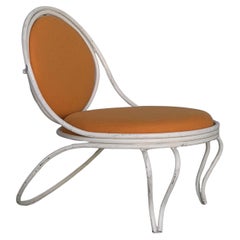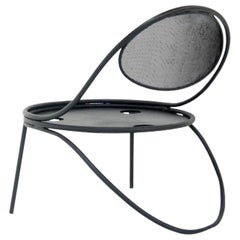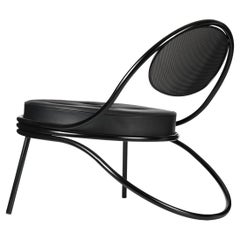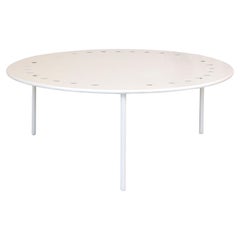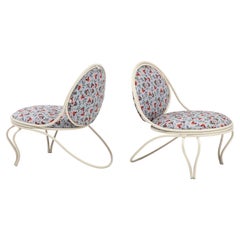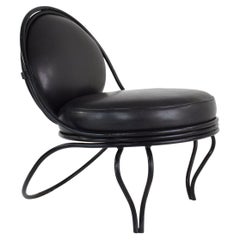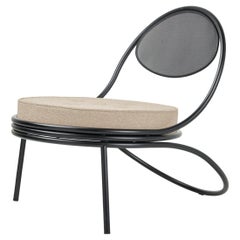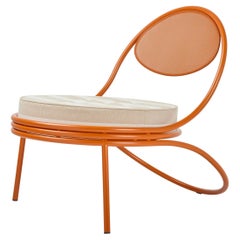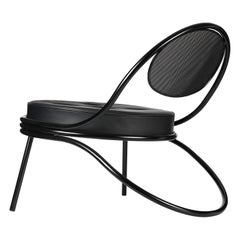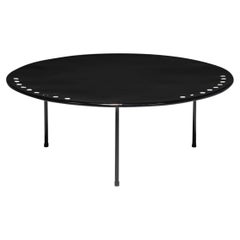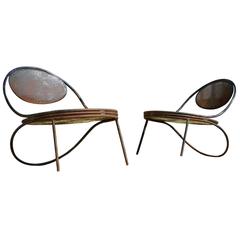Mategot Copacabana
Rare White Mathieu Matégot "Copacabana" Chair by Atelier Mategot France, 1954
By Mathieu Matégot
Located in Den Haag, NL
Rare Mathieu Matégot "Copacabana" Chair by Atelier Mategot France, 1954
Category
Vintage 1950s French Mid-Century Modern Lounge Chairs
Materials
Metal
$15,052
H 29.53 in W 23.63 in D 28.75 in
Mathieu Mategot Lounge chair model "Copacabana"
By Mathieu Matégot
Located in Barcelona, ES
Lounge chair model "Copacabana"
Manufactured by Atelier Mategot
France, 1950´s
Lacquered and
Category
Vintage 1950s French Chairs
Materials
Metal
Customizable Gubi Copacabana Lounge Chair by Mathieu Matégot
By Gubi, Mathieu Matégot
Located in New York, NY
The Copacabana lounge chair was created in 1955 by Mathieu Matégot. The low Copacabana Lounge Chair
Category
2010s Danish Lounge Chairs
Materials
Metal
$2,099 / item
H 27.56 in W 25.6 in D 33.47 in
Mid-Century Mathieu Matégot Coffee Table "Copacabana", circa 1955, France
By Mathieu Matégot
Located in Girona, Spain
Mid-Century Mathieu Matégot coffee table "Copacabana".
Made with steel.
Enameled in white.
Very
Category
Mid-20th Century French Mid-Century Modern Coffee and Cocktail Tables
Materials
Steel
$18,000
H 14.6 in Dm 37.4 in
Pair of Steel Copacabana Lounge Chairs by Mathieu Matégot, France
By Mathieu Matégot
Located in New York City, NY
Pair of lounge chairs by Mathieu Matégot, France, mid-20th century.
Newly Reupholstered in a
Category
Mid-20th Century French Mid-Century Modern Lounge Chairs
Materials
Upholstery
Rare Mid-Century Modern Copacabana Chair by Mathieu Matégot, 1955
By Mathieu Matégot
Located in Paris, FR
A rare collectible vintage lounge Copacabana chair by iconic French designer Mathieu Matégot
Category
20th Century French Mid-Century Modern Chairs
Materials
Steel
$8,429
H 31.5 in W 25.6 in D 22.84 in
'Copacabana' Indoor Outdoor Lounge Chair by Matégot in Lorkey Fabric for GUBI
By Gubi, Mathieu Matégot
Located in Glendale, CA
'Copacabana' Indoor Outdoor Lounge Chair by Matégot in Lorkey Fabric for GUBI
Few designs express
Category
21st Century and Contemporary Finnish Mid-Century Modern Chairs
Materials
Steel
$2,399 / item
H 30.8 in W 25.3 in D 34.1 in
'Copacabana' Indoor Outdoor Lounge Chair by Matégot in Leslie Fabric for GUBI
By Gubi, Mathieu Matégot
Located in Glendale, CA
'Copacabana' Indoor Outdoor Lounge Chair by Matégot in Leslie Fabric for GUBI
Few designs express
Category
21st Century and Contemporary Finnish Mid-Century Modern Chairs
Materials
Steel
$2,099 / item
H 30.8 in W 25.3 in D 34.1 in
Copacabana Lounge Chair
By Gubi, Mathieu Matégot
Located in Berkeley, CA
The Copacabana lounge chair was created in 1955 by Mathieu Matégot. The low Copacabana lounge chair
Category
21st Century and Contemporary Danish Mid-Century Modern Lounge Chairs
Materials
Metal
Recent Sales
Mathieu Matégot
Copacabana Table
By Mathieu Matégot
Located in Los Angeles, CA
Very rare Mathieu Matégot Copacabana Table. Enameled steel, France, 1955.
Category
Mid-20th Century French Mid-Century Modern Coffee and Cocktail Tables
Materials
Metal
Mathieu Matégot, Early Pair of Copacabana Easy Chair by Atelier Matégot, 1955
By Mathieu Matégot
Located in Munster, NRW
Coming from a private collection of the isle of ré in France, this pair of copacabana chairs by
Category
Vintage 1950s French Mid-Century Modern Lounge Chairs
Materials
Steel
H 27.56 in W 23.63 in D 23.63 in
Pair French Mid-Century Modern Iron 'Copacabana' Chairs, by Mathieu Matégot 1955
By Mathieu Matégot
Located in New York, NY
Rare pair of French Mid-Century Modern 'Copacabana' chairs in black enameled iron by Mathieu
Category
Vintage 1950s French Mid-Century Modern Lounge Chairs
Materials
Wrought Iron
Mathieu Mategot Copacabana lounge chair
Located in Oosterbeek, NL
very rare 50ies Mategot lounge chair
Ateliers Mategot France, 1955
pervorated metal
grate
Category
Vintage 1950s French Lounge Chairs
Materials
Metal
Mathieu Matégot Pair of Copacabana Lounge Chairs with Cushions
By Mathieu Matégot
Located in Brooklyn, NY
Pair of steel "Copacabana" chairs by Hungarian or French designer and material artist
Category
Mid-20th Century French Mid-Century Modern Lounge Chairs
Materials
Steel
Pair of White Copacabana Lounge Chairs by Mathieu Matégot, First Edition
By Mathieu Matégot
Located in Paris, FR
Pair of Copacabana Lounge Chairs created by Mathieu Matégot in 1955, round white enameled seating
Category
Vintage 1950s French Lounge Chairs
Materials
Iron
Mathieu Matégot "Nagasaki" Chair, circa 1954
By Mathieu Matégot
Located in Paris, FR
.
Comment : A "Must Have" from Mategot with the "Copacabana" chair.
Bibliography :
- «Le style 50
Category
Vintage 1950s French Art Deco Side Chairs
Materials
Metal
Coffee Table by Mathieu Mategot, France, Circa 1955
By Mathieu Matégot
Located in Fuveau, Provence
Rare Coffee Table by Mathieu Mategot model "Copacabana",
France, Circa 1955
White Lacquered
Category
Vintage 1950s French Modern Coffee and Cocktail Tables
Materials
Metal
Mathieu Mategot Chairs
Located in Newburgh, NY
Pair of Mathieu Mategot chairs, variation of the Copacabana model with a "Queen anne" leg
Category
Vintage 1950s French Slipper Chairs
Materials
Iron
People Also Browsed
Rare Set of Four Kaare Klint Armchairs in Mahogany and Niger Leather, 1920’s
By Kaare Klint, Rud Rasmussen
Located in Valby, 84
A rare and highly collectible set of four Kaare Klint armchairs, crafted from solid mahogany and upholstered in Niger leather. These chairs are a unique variation of the original des...
Category
Vintage 1920s Danish Scandinavian Modern Dining Room Chairs
Materials
Leather, Mahogany
$16,858 / set
H 29.93 in W 23.63 in D 18.12 in
Jean Prouvé Petit Potence Black Wall Lamp by Vitra
By Jean Prouvé, Vitra
Located in Amsterdam, NL
Industrial and minimalistic wall lamp designed by Jean Prouvé and produced by Vitra. The Potence swiveling wall lamp was designed by Jean Prouvé for the 'Maison Tropique' and is cons...
Category
Vintage 1940s German Mid-Century Modern Wall Lights and Sconces
Materials
Steel
Rosso Wall Mirror
By Specchi Veneziani
Located in Milan, IT
Venetian mirror made in the strictest Murano tradition. Assembled with crystal/gold and red elements handmade in the Murano furnaces. Wooden frame with a natural finish.
Category
2010s Italian Renaissance Wall Mirrors
Materials
Glass
Large and Fantastic Late 19th Century Carved Giltwood Bevelled Mirror
Located in Long Island City, NY
A Large and Fantastic Late 19th Century Carved Giltwood Mirror
Of rectangular form, with intricately hand carved sea shells and floral designs.
Details:
Height – 51 inches / 130cm...
Category
Antique Late 19th Century French Belle Époque Mantel Mirrors and Firepla...
Materials
Giltwood
Bauges French Mid-Century Metal and Murano Glass Bird Chandelier
By Maison Baguès
Located in Queens, NY
French mid-century (1940s) red and white painted metal 10 arm chandelier with Murano glass bird in center with canopy. (Attributed to BAGUES).
Category
Vintage 1940s French Mid-Century Modern Chandeliers and Pendants
Materials
Metal
Jean-Michel Frank and Adolphe Chanaux Pair "Armchair 40" Club Chairs by Ecart
By Jean-Michel Frank, Ecart International, Adolphe Chanaux & Co.
Located in Cathedral City, CA
Jean Michel Frank and Adolphe Chanaux for Ecart International Pair of Club Chairs, "Armchair 1940". Ecart has re-edited this design and has been producing it from their Paris showroo...
Category
Early 2000s French Art Deco Club Chairs
Materials
Fabric, Wool, Upholstery, Oak
$6,800 / set
H 36.25 in W 36.5 in D 36.5 in
Pair of Classical Fluted Columns
Located in New York, NY
Pair of wood fluted columns with gilt band on base. Columns show their age beautifully. Small cracks in base that do not effect their structural integrity.
Category
Vintage 1950s Classical Greek Pedestals and Columns
Materials
Giltwood, Wood
SCONCE Serge Mouille "Flamme" or Flame Candle Stands
By Serge Mouille
Located in London, GB
Serge Mouille applique
Category
Early 20th Century French Mid-Century Modern Wall Lights and Sconces
Materials
Aluminum, Steel
Henning Kjærnulf, Set of 12 Chairs, Oak & Hessian, Mid Century Modern, 1960s
By Henning Kjærnulf
Located in Odense, DK
An incredible set of 12 dining chairs in oak, seat & back reupholstered in a organic hessian, adding a touch of rustic charm while ensuring comfort and durability. This set is in the...
Category
Mid-20th Century Danish Baroque Dining Room Chairs
Materials
Oak, Burlap
$9,000 / set
H 33.08 in W 19.69 in D 17.33 in
Pair of Constant Night Stands in Iroko Wood by Master Studio for Lemon
By Lemon
Located in Amsterdam, NL
Neatly proportioned with exceptional detailing, the constant nightstand is your perfect bedside partner. In our furniture making, the IDEA is to create special pieces that you can bu...
Category
2010s South African Minimalist Pedestals
Materials
Hardwood
$6,342 / set
H 24.01 in Dm 13.78 in
Elegant Mid Century Modern Pine Wood Flush Mount or Ceiling Lamp Sweden 1970s
Located in Munich, DE
Elegant and highly decorative Mid-Century Modern square ceiling lamp or flush mount with removable wood grids. Designed & manufactured in Sweden, 1970s.
Two identical pieces are ava...
Category
Vintage 1970s Swedish Mid-Century Modern Flush Mount
Materials
Metal
$1,445
H 4.73 in W 13 in D 13 in
French Limed Oak Armoire
Located in Antwerp, BE
Limed oak two door armoire.
Height 210 cm.
Width 127 cm.
Depth 64 cm.
Category
Late 20th Century French Mid-Century Modern Wardrobes and Armoires
Materials
Glass, Wood, Oak
French Art Deco Console
Located in Long Island City, NY
A Classic French Art Deco wooden carved console in green patina. Polygonal top shape in predominately geometric motifs with fine carving details. The console features a beautiful mat...
Category
Mid-20th Century French Art Deco Console Tables
Materials
Wood
Armchair Móveis Bertomeu' in Rosewood - Brazil 1960
By Bertomeu & Cia
Located in Curitiba, PR
Móveis Bertomeu was a Brazilian furniture manufacturer active during the 1960s, known for its contributions to mid-century modern design in Brazil. The company specialized in creatin...
Category
Vintage 1960s Brazilian Mid-Century Modern Armchairs
Materials
Rosewood
Brazilian Designer, Counter Stools, Wood, Velvet, Brazil, 1950s
Located in High Point, NC
A set of three bar or counter stools designed and produced in Brazil, c. 1950s.
Overall Dimensions (inches): 19.25"H x 12.875"W x 12.875"D
Seat Height (inches): 19.25"
All upholst...
Category
Vintage 1950s Brazilian Mid-Century Modern Stools
Materials
Velvet, Wood
1924 René Lalique - Tablewares Bowls Coquilles Shells Glass With Blue Patina
By René Lalique
Located in Boulogne Billancourt, FR
Set of tablewares bowls "Shells" made in glass with blue patina by René Lalique in 1924.
Signature on each piece.
All pieces are in perfect condition.
Set of 8 pieces including:
- ...
Category
Vintage 1920s French Art Deco Tableware
Materials
Glass
$3,311 / set
H 1.97 in Dm 5.12 in
Get Updated with New Arrivals
Save "Mategot Copacabana", and we’ll notify you when there are new listings in this category.
